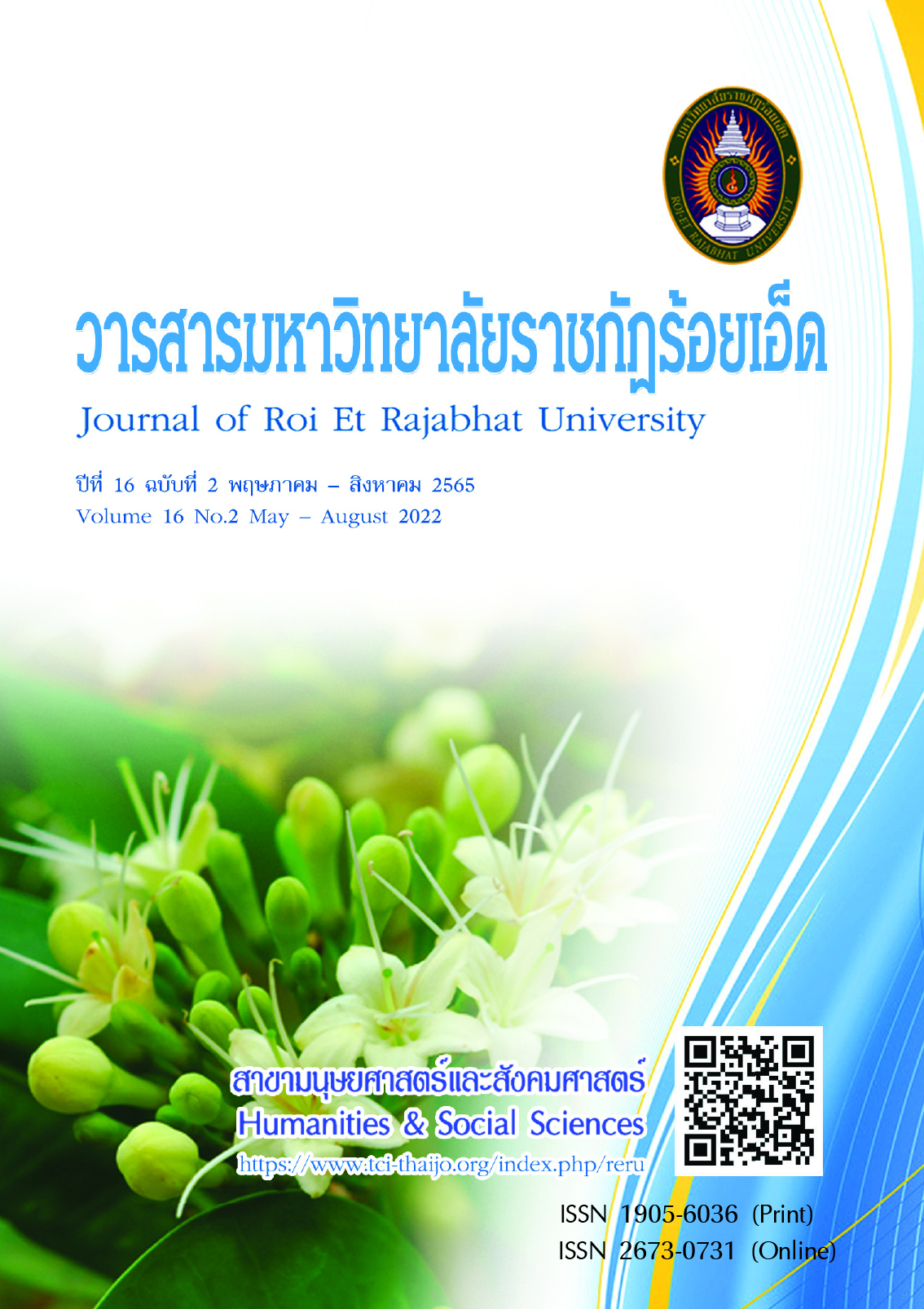Budget Administration Affecting the Effectiveness of Schools in the Secondary Educational Service Area Office 27
Keywords:
Budget Administration, School Effectiveness, The Secondary Educational Service Area Office 27Abstract
The objectives of this research were to 1) study educational institution budget management;
2) study educational institution effectiveness; and 3) explore budget management affecting educational institution effectiveness under Secondary Education Service Area Office 27. This study's sample included 396 administrators and instructors from the schools under the Secondary Educational Service Area Office 27. A questionnaire with a 5-point rating scale was utilized to collect data. Frequency, percentage, mean,
and standard deviation were the statistics employed in data analysis. The hypothesis of this study was tested using stepwise multiple regression. The findings revealed that 1) both the overall and each part
of budget management in schools under the Secondary Educational Service Area office 27 were rated
at a high level, 2) the overall efficacy of schools in the Secondary Educational Service Area office 27 was rated at a high level. When considering each component, it was discovered to be effective at a high level in practically every aspect, with the exception of the school environment and the leadership. These two factors received the highest rating, and 3) In the Secondary Educational Service Area Office 27, it was discovered that the element of planning (X1) was the best predictor of school effectiveness, followed
by material and property management (X5), budget management (X2), and financial and accounting management (X6), respectively. These factors may explain 86.60 percent of the variance in school effectiveness in the Secondary Educational Service Area Office 27 with statistical significance at .01 level. The regressive coefficients in raw score form were 0.254, 0.286, 0.171, and 0.112, while in standard score form were 0.325, 0.366, 0.295, and 0.123. The followings are possible predictive equations:
The regressive equation of school effectiveness in raw score form (Unstandardized Score)
Y´ = 0.863 + 0.254 X1 + 0.286 X5 + 0.171 X2 + 0.112 X6
The regressive equation of school effectiveness in standard score form (Standardized Score)
Z´y = 0.325ZX1 + 0.366ZX5 + 0.295ZX2 + 0.123ZX6
References
กนกวรรณ รองเมือง และสมใจ ภูมิพันธุ์. (2562). การบริหารแบบมีส่วนร่วมที่ส่งผลต่อประสิทธิผลของโรงเรียนสังกัดสำนักงานเขตพื้นที่การศึกษาประถมศึกษามุกดาหาร. วารสารมนุษยศาสตร์และสังคมศาสตร์ มหาวิทยาลัยนครพนม, 9(2), 33-41.
กระทรวงศึกษาธิการ. (2556). คู่มือการบริหารโรงเรียนในโครงการพัฒนาการบริหารรูปแบบนิติบุคคล. กรุงเทพฯ: สำนักงานคณะกรรมการการศึกษาขั้นพื้นฐาน.
กระทรวงศึกษาธิการ. (2550). แนวทางการกระจายอำนาจการบริหารและการจัดการศึกษาให้คณะกรรมการสำนักงานเขตพื้นที่การศึกษาและสถานศึกษา ตามกฎกระทรวงกำหนดหลักเกณฑ์และวิธีการกระจายอำนาจการบริหารและการจัดการศึกษา พ.ศ. 2550. กรุงเทพฯ: โรงพิมพ์ชุมนุมสหกรณ์การเกษตรแห่งประเทศไทย จำกัด.
กระทรวงศึกษาธิการ. (2546). คู่มือการบริหารสถานศึกษาขั้นพื้นฐานที่เป็นนิติบุคคล. กรุงเทพฯ: โรงพิมพ์องค์การรับส่งสินค้าพัสดุภัณฑ์.
ขนิษฐา ยศเมฆ. (2560). ความสัมพันธ์ระหว่างการบริหารงบประมาณทางการศึกษากับคุณภาพผู้เรียนของสถานศึกษา สังกัดเทศบาลในจังหวัดสุราษฎร์ธานี. วิทยานิพนธ์ ครุศาสตรมหาบัณทิต สาขาวิชาการบริหารการศึกษา. สุราษฎร์ธานี: มหาวิทยาลัยราชภัฏสุราษฎร์ธานี.
จิตรวี ซื่อสัตย์. (2559). ความสัมพันธ์ของการบริหารงบประมาณแบบมุ้งเน้นผลงานกับประสิทธิผลการบริหารงานวิชาการของโรงเรียนมัธยมศึกษาจังหวัดพะเยา สังกัดสำนักงานเขตพื้นที่การศึกษามัธยมศึกษา เขต 36. วิทยานิพนธ์ การศึกษามหาบัณฑิต สาขาวิชาการบริหารการศึกษา. พะเยา: มหาวิทยาลัยพะเยา.
จันทรานี สงวนาม. (2551). ทฤษฎีและแนวปฏิบัติในการบริหารสถานศึกษา (พิมพ์ครั้งที่ 2). กรุงเทพฯ: บุ๊ค พอยท์.
ไชยา ภาวะบุตร. (2555). หลัก ทฤษฎีและการปฏิบัติ การบริหารการศึกษา (พิมพ์ครั้งที่ 2). สกลนคร: มหาวิทยาลัยราชภัฏสกลนคร.
ธร สุนทรายุทธ. (2551). การบริหารจัดการเชิงปฏิรูป. กรุงเทพฯ: เนติกุลการพิมพ์.
บุญชม ศรีสะอาด. (2556). การวิจัยเบื้องต้น ฉบับปรับปรุงใหม่ (พิมพ์ครั้งที่ 9). กรุงเทพฯ: สุวีริยาสาส์น.
ปนัดดา จันตุ่ย และสิรินธร สินจินดาวงศ์. (2563). ความสัมพันธ์ระหว่างการบริหารความขัดแย้งกับประสิทธิผลของสถานศึกษา เครือข่ายการศึกษาสุนทรภู่ สำนักงานเขตพื้นที่การศึกษาประถมศึกษาระยอง เขต 2. วารสารมหาวิทยาลัยราชภัฏร้อยเอ็ด, 14(2), 3-12.
ภารดี อนันต์นาวี. (2553). หลักการ แนวคิด ทฤษฎี ทางการบริหารการศึกษา (พิมพ์ครั้งที่ 3) (ฉบับปรับปรุงครั้งที่ 2). ชลบุรี: มนตรี.
ยุพิน บุญวิเศษ. (2555). การศึกษาสภาพและปัญหาการบริหารงบประมาณของโรงเรียนในภาคตะวันออกเฉียงเหนือ สังกัดสำนักงานเขตพื้นที่การศึกษามัธยมศึกษา. วิทยานิพนธ์ ครุศาสตรมหาบัณฑิต สาขาวิชาบริหารการศึกษา. กรุงเทพฯ: จุฬาลงกรณ์มหาวิทยาลัย.
วิโรจน์ สารรัตนะ. (2553). ผู้บริหารโรงเรียนสามมิติการพัฒนาวิชาชีพสู่ความเป็นผู้บริหารที่มีประสิทธิผล (พิมพ์ครั้งที่ 7). กรุงเทพฯ: ทิพย์วิสุทธิ์.
สำนักงานเขตพื้นที่การศึกษามัธยมศึกษา เขต 27. (2561). รายงานการประชุมผู้อำนวยการโรงเรียนมัธยมศึกษา สังกัดสำนักงานเขตพื้นที่การศึกษามัธยมศึกษา เขต 27. ครั้งที่ 8/2561. วันที่ 5 พฤศจิกายน 2561. ร้อยเอ็ด: สำนักงานเขตพื้นที่การศึกษามัธยมศึกษา เขต 27. 23-25.
สำนักงานคณะกรรมการการศึกษาขั้นพื้นฐาน. (2552). คู่มือการตรวจสอบภายในสถานศึกษา เล่ม 2. กรุงเทพฯ: สำนักงานคณะกรรมการการศึกษาขั้นพื้นฐาน.
สำนักงานคณะกรรมการการศึกษาขั้นพื้นฐาน. (2548). คู่มือการตรวจสอบภายในสถานศึกษา เล่ม 1 การเงินการบัญชี: คู่มือการบัญชีสำหรับหน่วยงานย่อย พ.ศ. 2515. กรุงเทพฯ: สำนักงานคณะกรรมการการศึกษาขั้นพื้นฐาน.
สำนักงานเลขาธิการสภาการศึกษา. (2549). 15 รูปแบบการบริหารโรงเรียน ของผู้บริหารสถานศึกษาต้นแบบรุ่นที่ 1 ปี 2544. กรุงเทพฯ: 21 เซ็นจูรี่.
Austin, G. E. and Raynolds, D. (1990). Managing for improved school effectiveness: An international survey. School Organization, 10(2/3), 167-178.
Glickman, C. D. and Ross-Grodon, J. M. (2001). Supervision and instructional leadership a developmental Approach (5th ed.). Boston: Allyn and Bacon.
Herzog, A. J. (1990). Variables contributing to organizational effectiveness: A comparison between national exemplary secondary schools and lutheran secondary schools. Dissertation Abstracts International, 51(8), 2582.
Hanson, M. E. (2002). Educational administration and organization behavior (5th ed.). Boston: Allyn and Bacon.
Hoy, W. K. and Miskel, C. G. (2001). Education administration: Theory research practice (4th ed.). New York: McGraw-Hill.
Katz, D. and Kahn, R. L. (1978). The social psychology of organizations (2nd ed.). New York: Wiley.
Lunenberg, C. F. and Ornstein, C. A. (2004). Educational adminstration: Concepts and practices (4th ed.). New York: WadsWorth.
Marcel, K. (1990). Principal power and school effectivenes: A study of urban public middle school. Dissertation Abstracts International, 51(6), 185.
Pierce, L. V. (1992). Effective schools for national origin language minority students. Washington DC: The Mid Atlantic Equity Center.
Sammons, P., Hillman, J. and Mortimore, P. (1995). Key characteristics of effective schools: A review of school effectiveness research. London: Office for Standards in Education.
Senge, P. M. (1996). The fifth discipline of learning organization. London: Century Business.
Sergiovanni, T. J. (2009). The principalship: A reflective practice perspective (5th ed.). Boston: Allyn and Bacon.
Downloads
Published
How to Cite
Issue
Section
License
Copyright (c) 2022 Roi Et Rajabhat University

This work is licensed under a Creative Commons Attribution-NonCommercial-NoDerivatives 4.0 International License.
บทความที่ได้รับการตีพิมพ์เป็นลิขสิทธิ์ของวารสารมหาวิทยาลัยราชภัฎร้อยเอ็ด
ข้อความที่ปรากฏในบทความแต่ละเรื่องในวารสารวิชาการเล่มนี้เป็นความคิดเห็นส่วนตัวของผู้เขียนแต่ละท่านไม่เกี่ยวข้องกับมหาวิทยาลัยราชภัฎร้อยเอ็ด และคณาจารย์ท่านอื่นๆในมหาวิทยาลัยฯ แต่อย่างใด ความรับผิดชอบองค์ประกอบทั้งหมดของบทความแต่ละเรื่องเป็นของผู้เขียนแต่ละท่าน หากมีความผิดพลาดใดๆ ผู้เขียนแต่ละท่านจะรับผิดชอบบทความของตนเองแต่ผู้เดียว





